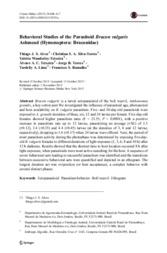Behavioral studies of the parasitoid Bracon vulgaris ashmead (Hymenoptera: Braconidae).
Behavioral studies of the parasitoid Bracon vulgaris ashmead (Hymenoptera: Braconidae).
Author(s): ALVES, T. J. S.; SILVA-TORRES, C. S. A.; WANDERLEY-TEIXEIRA, V.; TEIXEIRA, A. A. C.; TORRES, J. B.; LIMA, T. A.; RAMALHO, F. de S.
Summary: Bracon vulgaris is a larval ectoparasitoid of the boll weevil, Anthonomus grandis, a key cotton pest We investigated the influence of parasitoid age, photoperiod and host availability on B. vulgaris parasitism. Five- and 10-day-old parasitoids were exposed to A. grandis densities of three, six, 12 and 24 larvae per female. Five-day-old females showed higher parasitism rates (F = 21.55, P < 0.0001), with a positive increase in parasitism rate up to 12 larvae, parasitizing an average (±SE) of 1.3 (±0.12), 3.4 (±0.35) and 4.4 (±0.45) larvae (at the densities of 3, 6 and 12 larvae, respectively), dropping to 1.4 (±0.17) when 24 larvae were offered. Next, the period of most parasitism activity during the photophase was determined by exposing five-dayold B. vulgaris females to different durations of light exposure (1, 3, 6, 8 and 10 h) after 12 h darkness. Results showed that the shortest time to host location occurred 8 h after light exposure, when parasitoids were most active searching for the host. A sequence of seven behavioral acts leading to successful parasitism was identified and the transitions between successive behavioral acts were quantified and depicted in an ethogram. The longest duration act was oviposition (or host acceptance), a complex behavior with several distinct phases.
Publication year: 2015
Types of publication: Journal article
Unit: Embrapa Cotton
Observation
Some of Embrapa's publications are published as ePub files. To read them, use or download one of the following free software options to your computer or mobile device. Android: Google Play Books; IOS: iBooks; Windows and Linux: Calibre.
Access other publications
Access the Agricultural Research Database (BDPA) to consult Embrapa's full library collection and records.
Visit Embrapa Bookstore to purchase books and other publications sold by Embrapa.

